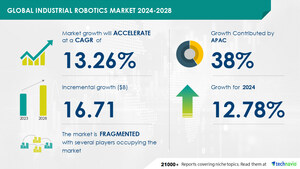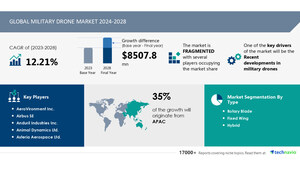NEW YORK, April 22, 2024 /PRNewswire/ -- The global software-defined radios market size is estimated to grow by USD 12894.6 mn from 2023 to 2027, according to Technavio. The market is estimated to grow at a CAGR of 8% during the forecast period. North America held the largest share of the global market in 2022, and the market in the region is estimated to witness an incremental growth of 35%.
To understand more about this market- Download a FREE Sample Report in minutes!
Major Players in the Market
Numerous companies are capitalizing on this growing trend by implementing strategic measures such as alliances, partnerships, mergers, and acquisitions. Among the notable players in the cheese based snacks market are:
ASELSAN AS, BAE Systems Plc, Bharat Electronics Ltd., Elbit Systems Ltd., General Dynamics Corp., Huawei Technologies Co. Ltd., Indra Sistemas SA, L3Harris Technologies Inc., Leonardo Spa, Mercury Systems Inc., Northrop Grumman Systems Corp., NXP Semiconductors NV, Rafael Advanced Defense Systems Ltd., Raytheon Technologies Corp., Rohde and Schwarz GmbH and Co. KG, Rolta India Ltd., Thales Group, Ultra Electronics Holdings Plc, Viasat Inc., ZTE Corp.
Analyst Review
The Software-Defined Radios (SDR) market is experiencing significant growth in defense agencies due to the adoption of next-generation technology. SDR utilizes digital components, such as general-purpose processors, firmware, modifiable software, and analog-to-digital converters, to provide flexible communication solutions. Defense budgets prioritize the integration of SDR in various frequency bands, including S-band, L-band, and UHF, to enhance wireless capabilities. Security concerns are addressed through the use of cognitive radio technology and communication standards. SDR components, including mixers, antennae, filters, application-specific ICs, and field-programmable gate arrays, are essential for the development of advanced SDR systems. DARPA's ongoing research in this area underscores the importance of SDR in defense applications. Overall, the market for SDR is poised for continued expansion as defense agencies seek to modernize their communication systems.
Key Market Drivers
The Software-Defined Radio (SDR) market holds a strategic edge in the communication technology landscape, with digital radio solutions replacing traditional analog radio systems. SDRs offer spectral efficiency, enabling the efficient use of spectrum, and are adaptable to various digital modulation schemes, making them ideal for wireless communication in the telecommunications sector. SDRs provide voice clarity and noise reduction, enhancing user experience in mission-critical operations, healthcare applications, and remote patient monitoring. Consolidations and regulatory scrutiny characterize this market, with spectrum flexibility and interoperability key considerations. The defense and aerospace sectors leverage SDRs for their adaptability and security concerns. Next-generation software, such as DARPA's research, drives innovation in this field. Cognitive radio technology and communication standards are essential components, with general-purpose processors, digital signal processors, integrated circuits, amplifiers, antennas, converters, and cognitive/intelligent radio systems integral to SDR development. 5G technology and defense spending fuel growth in the SDR market, with applications ranging from general-purpose radio to terrestrial trunked radio and BNET NANO. Security concerns persist, necessitating ongoing research and development.
Challenges and Opportunities
The Software-Defined Radio (SDR) market is experiencing growth despite the challenges posed by its complexity. SDRs enable Multi-Channel Reception and are integral to 5G network infrastructure. Their modifiable software and firmware make them adaptable to various communication devices and applications, including IoT, Cloud, and AI Technology. SDRs utilize analog-to-digital and digital-to-analog converters, mixers, antennae, filters, application-specific ICs, field-programmable gate arrays, and general-purpose processors. SDRs' wireless capabilities enable seamless integration with 5G networks, enhancing system performance. SDRs face interoperability challenges with legacy communication systems, necessitating testing. They require additional components like antennae, filters, and power systems. SDRs are essential in various sectors, including aerospace, telecommunications systems, military applications, and emergency services. Military authorities and tactical communication applications utilize SDRs in VHF and UHF frequencies. Modern communication systems, including Fire Series, prioritize SDRs for their flexibility and advanced features. Despite these complexities, SDRs offer communication security against software attacks and are vital for naval, air, armed forces, and transport services.
The Software-Defined Radio (SDR) market holds significant potential in defense applications due to its flexibility and reconfigurability. SDR technology, used in advanced communication systems like LTE and 5G, supports multiple communication standards and frequencies, including S-band, L-band, and UHF bands. Defense agencies allocate substantial budgets towards SDR technology for secure and dependable communication in modern warfare. SDRs offer improved performance and cost savings compared to traditional hardware systems. In defense and aerospace sectors, SDRs provide mission-critical operational efficiency and a strategic edge. SDRs support digital radio technology, offering voice clarity and noise reduction for secure communication. SDRs' adaptability makes them suitable for various applications, such as mission-critical operations, healthcare applications, and remote patient monitoring. Consolidations and regulatory scrutiny characterize the telecommunications sector, driving the need for spectrum flexibility and interoperability. Defense spending on next-generation software, including SDR technology, continues to grow. DARPA, a leading research organization, invests in digital modulation schemes and wireless communication for 5G technology. The market's future lies in providing rapid communication solutions for defense applications, ensuring interoperability, and enhancing user experience. Analog and digital radio systems coexist, with digital radio systems gaining popularity due to their spectral efficiency and advanced features. The SDR market's growth is driven by the need for adaptable, mission-critical communication technology in defense and aerospace sectors.
To understand more about this market- Download a FREE Sample Report in minutes!
Market Overview
The Software-Defined Radios (SDR) market is experiencing significant growth due to the flexibility and cost-effectiveness they offer compared to traditional radios. SDRs enable digital signal processing, allowing for real-time monitoring and analysis of radio frequencies. This technology is crucial in various sectors, including telecommunications, military, and scientific research. The SDR market is driven by factors such as increasing demand for wireless communication, the need for interoperability, and advancements in technology. The SDR market encompasses components such as transceivers, antennas, software, and integration services. The future of SDRs lies in their ability to support advanced applications, such as cognitive radio and software-defined networking.
About Technavio
Technavio is a leading global technology research and advisory company. Their research and analysis focuses on emerging market trends and provides actionable insights to help businesses identify market opportunities and develop effective strategies to optimize their market positions.
With over 500 specialized analysts, Technavio's report library consists of more than 17,000 reports and counting, covering 800 technologies, spanning across 50 countries. Their client base consists of enterprises of all sizes, including more than 100 Fortune 500 companies. This growing client base relies on Technavio's comprehensive coverage, extensive research, and actionable market insights to identify opportunities in existing and potential markets and assess their competitive positions within changing market scenarios.
Contacts
Technavio Research
Jesse Maida
Media & Marketing Executive
US: +1 844 364 1100
UK: +44 203 893 3200
Email: [email protected]
Website: www.technavio.com/
SOURCE Technavio

WANT YOUR COMPANY'S NEWS FEATURED ON PRNEWSWIRE.COM?
Newsrooms &
Influencers
Digital Media
Outlets
Journalists
Opted In





Share this article